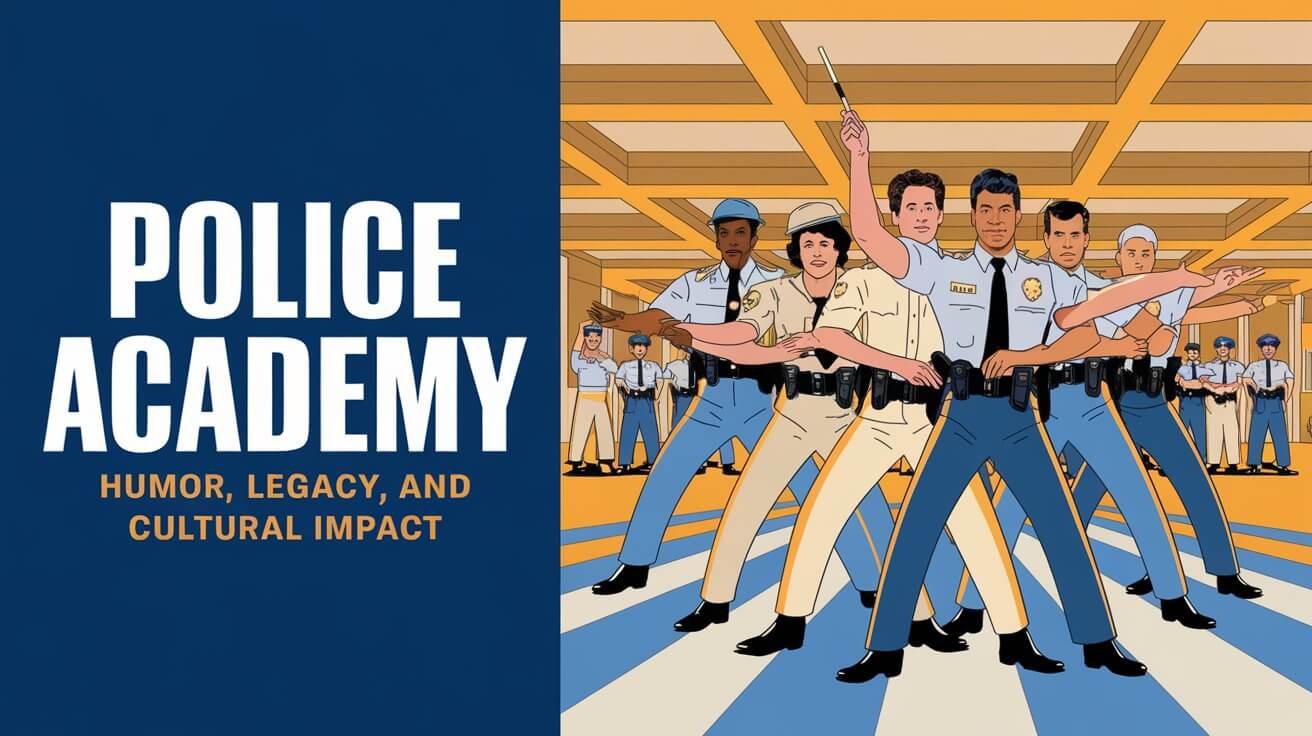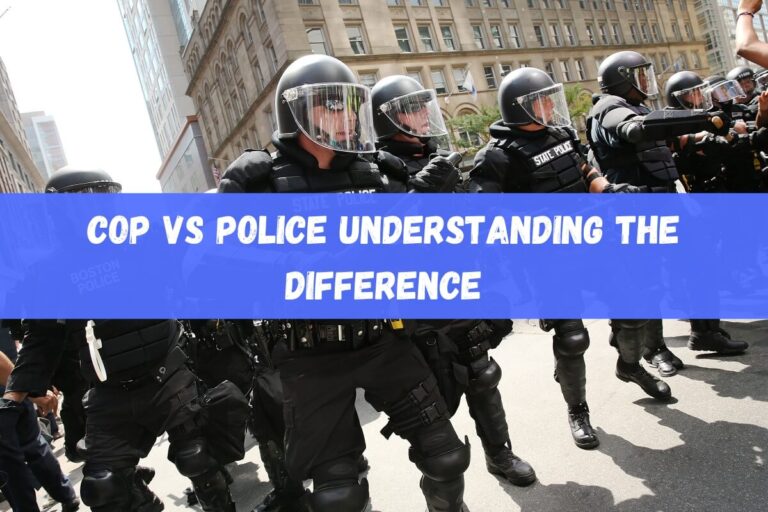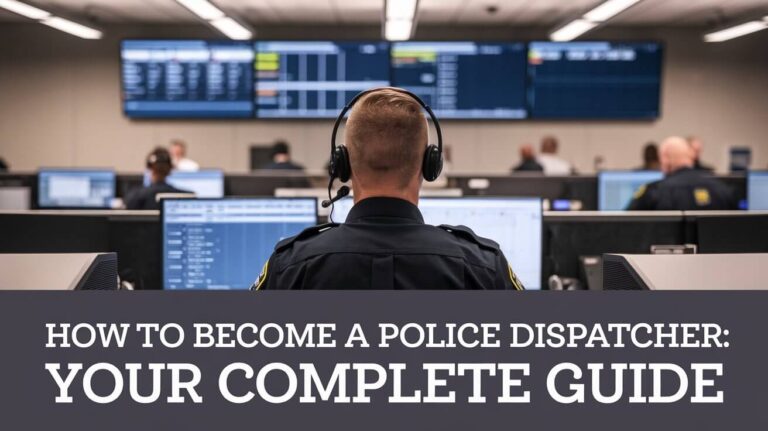Police Academy: Humor, Legacy, and Cultural Impact

The Police Academy is a top place for those wanting to be in law enforcement. It offers detailed training and career advice. Students get a solid education in law enforcement and criminal justice.
The academy has the latest facilities and expert teachers. They prepare students for the tough job of a police officer.
Out of 100 people without experience, only 5 get hired as police officers. It’s a tough field that needs a lot of effort. The Police Academy aims to give the best training in law enforcement and criminal justice. They want to help students do well in their police career.
Basic Requirements for Police Academy Admission
To join the police academy, you must meet certain requirements. You need to be at least 20 years old. Also, you must have a high school diploma or a GED. A background check is required, which looks into your criminal history.
You can’t have any felony convictions. You also can’t have been convicted of a crime that could get you more than two years in jail. You must score well on a reading test, showing you can read at a tenth-grade level. You’ll also need to pass a drug test and a psychological screening by a licensed professional.
Age and Citizenship Requirements
To apply, you must be a U.S. citizen. The age limit is 20 years old, and there’s no upper limit.
Background Check Standards
A background check is key in the application process. It looks at your criminal history, driving record, and more. The standards are strict, and you must meet them to be considered.
| Requirement | Description |
|---|---|
| Age | Minimum 20 years |
| Citizenship | United States citizen |
| Education | High school diploma or GED |
| Background Check | No felony convictions, no crimes punishable by more than two years |
Meeting these requirements is the first step to a career in law enforcement. The application process is tough. But it’s important to make sure only the best join the police force.
Physical Fitness Standards at the Academy
Physical fitness is key in police academy training. It prepares students for the demands of law enforcement. The academy’s program includes running, weightlifting, and obstacle courses. These help students meet the physical demands of their job.
The Physical Fitness Qualifier (PFQ) tests a candidate’s fitness level. It has four events: sit-ups, a 300-meter sprint, push-ups, and a 1.5-mile run. Male candidates should aim for a 1.5-mile run time of 9:44 minutes or less. Female candidates should aim for under 12:30 minutes.
- Average to good finishing times for men on the 1.5-mile run range from 10:30 to 12 minutes.
- Average to good finishing times for women on the 1.5-mile run range from 13:30 to 16 minutes.
- The fitness test includes a requirement to complete a 300-meter sprint in at least 78 seconds.
Law enforcement fitness is vital for police officers. It helps them respond to emergencies and protect themselves and others. The academy’s program pushes students hard. This helps them build the strength, endurance, and agility needed for their careers.
Meeting the academy’s physical fitness standards, students are ready for law enforcement challenges. They can provide effective service to their communities.
Daily Life Inside Police Academy Training
Life in the police academy is strict and follows a set routine. The day starts with morning routines and protocols. These include roll call, inspections, and other activities to get cadets ready for law enforcement training.
Academic classes are a big part of the day. They cover law enforcement procedures, criminal justice, and first aid. These classes give cadets the knowledge and skills they need for their careers. Physical training is also key, with exercises to improve fitness and prepare for law enforcement’s physical demands.
Morning Routines and Protocols
Cadets start their day with a morning routine. This includes roll call, inspections, and other activities. It helps establish discipline and structure, which is vital for law enforcement training. The morning routine also lets cadets review the day’s schedule and prepare for activities.
Academic Classes Schedule
Academic classes are scheduled throughout the day. They focus on law enforcement procedures, criminal justice, and more. The classes are interactive and aim to give cadets the knowledge and skills for their careers.
Physical Training Sessions
Physical training is a big part of the day. It aims to improve fitness and prepare cadets for law enforcement’s physical demands. The training includes running, strength training, and agility drills. It helps cadets develop the physical skills and endurance needed for law enforcement.
Academic Curriculum Components
The police academy curriculum is made to give students a full education in law enforcement and criminal justice. It includes many law enforcement courses, like procedures, criminal justice, and first aid. These courses help students get the knowledge and skills needed for a career in law enforcement.
Some key parts of the police academy curriculum are:
- Law enforcement procedures
- Criminal justice
- First aid and emergency response
- Defensive tactics and officer safety
Curriculum also covers criminal law, ethics, and report writing. Its goal is to give students a well-rounded education. This prepares them for the challenges of a career in law enforcement.
| Course | Description |
|---|---|
| Law Enforcement Procedures | Covers the basics of law enforcement, including arrest procedures and search and seizure laws |
| Criminal Justice | Explores the criminal justice system, including the role of law enforcement, courts, and corrections |
| First Aid and Emergency Response | Teaches students how to respond to medical emergencies and provide basic first aid |
Police academy curriculum is designed to equip students with the knowledge and skills for a career in law enforcement. It combines law enforcement courses with training in criminal justice and other fields. This provides a complete education that prepares students for the challenges of a career in law enforcement.
Firearms Training and Safety Protocols
At the Police Academy, firearms training is key. It focuses on safety and following law enforcement rules. The program includes hands-on training, simulation exercises, and classroom lessons. This ensures cadets know how to handle weapons safely and meet qualification standards.
The training teaches cadets how to use firearms safely and well. They learn about loading, aiming, and firing. They also learn about range safety to avoid accidents. Cadets practice in simulations like MILO, which helps them make quick decisions and solve problems.
Vital Segments of Firearms Training
- Weapon handling fundamentals, including loading, unloading, and firing
- Range safety guidelines, such as proper use of protective gear and adherence to shooting protocols
- Qualification requirements, including tests and evaluations to assess proficiency
Police Academy puts a big focus on firearms training and safety. This makes sure cadets are ready for law enforcement duties. It also keeps everyone safe and promotes professionalism.
Law Enforcement Driving Skills
At the Police Academy, students learn a lot about driving for law enforcement. They get training in vehicle operations and safety. This program helps them know how to drive safely and well in police work.
Defensive driving is a big part of the training. It teaches students to avoid accidents and stay safe. They also learn to follow traffic laws and watch out for dangers on the road. This way, they can drive well and do their job well.
Some key parts of the driving skills program include:
- Vehicle operations and safety protocols
- Defensive driving techniques
- Traffic laws and regulations
- Hazard awareness and response
The driving skills program is a key part of law enforcement training. It helps students learn and feel confident in their duties. The program mixes theory and practice, giving students a deep understanding of police driving and vehicle operations.
| Course | Class Dates | Registration Period |
|---|---|---|
| 175 Basic Law Enforcement | Aug 26, 2024 – Feb 7, 2025 | Jun 1, 2024 – Jul 29, 2024 |
| 176 Basic Law Enforcement | Nov 18, 2024 – Apr 24, 2025 | Sep 2, 2024 – Oct 11, 2024 |
| 177 Basic Law Enforcement | Feb 24, 2025 – Jul 16, 2025 | Dec 2, 2024 – Feb 7, 2025 |
Defense Tactics and Officer Safety
At the Police Academy, learning defense tactics and officer safety is key. The program teaches students how to protect themselves and others. It includes training in hand-to-hand combat, arrest techniques, and survival skills.
The curriculum covers many topics, like controlling suspects and de-escalation strategies. It focuses on using the least amount of force possible. For example, de-escalation training lasts 2 hours, showing the value of good communication and teamwork.
It also teaches how to handle armed suspects and control crowds. This training prepares officers for stressful situations. It emphasizes the importance of being ready and analyzing scenarios.
Key Components of Defense Tactics Training
- Hand-to-hand combat training to defend against physical attacks
- Arrest techniques, including training in how to safely and effectively arrest and restrain suspects
- Officer survival skills, including training in how to respond to emergency situations and stay safe in high-risk environments
The Police Academy’s defense tactics and officer safety program is vital. It gives students the skills and knowledge to stay safe and protect others. By including this training, the academy prepares officers for various situations, from routine stops to emergencies.
| Training Topic | Duration |
|---|---|
| De-escalation strategies | 2 hours |
| Hand-to-hand combat training | Varies |
| Arrest techniques | Varies |
Legal Studies and Constitutional Law
Legal studies and constitutional law are key parts of the Police Academy’s training. Students learn about the legal system and their role in it. They study criminal law basics and civil rights procedures.
The program covers constitutional law deeply. It includes the Fourth Amendment and search and seizure rules. Students also learn about the Fifth Amendment and Miranda warnings. They understand the U.S. government’s structure and individual rights.
Criminal Law Basics
Criminal law basics are vital in the program. Students discover different crime types, like drug and theft crimes. They also learn about the Fifth Amendment and Miranda warnings.
Civil Rights and Procedures
Civil rights and procedures are key too. Students learn to protect citizens’ rights and follow law enforcement procedures. They learn about searches and warrants. The program also covers First Amendment rights and public employee duties.
Court System Overview
Students get a court system overview. They learn how courts work and how to testify. They understand federal and state courts and evidence presentation. The goal is to prepare students for the court system and their role in it.
Communication and De-escalation Techniques
Effective communication is key in law enforcement training. It helps officers talk to citizens in a professional way. De-escalation techniques are also important. They help officers solve tense situations without violence.
Studies show that de-escalation training works well. Officers who got eight hours of training had 26% fewer complaints. They also used force 28% less.
De-escalation training has many benefits. It reduces violence, keeps officers safe, and builds trust with the community.
- Reduced use-of-force incidents
- Decreased officer injuries
- Improved community relationships
- Increased public trust
A study by the University of Cincinnati found a big drop in violence. A police department saw a 28% decrease in force after training. The San Francisco police also saw a 24% drop in 2019.
| Department | Decrease in Use-of-Force Incidents |
|---|---|
| San Francisco Police Department | 24% |
| Large Metropolitan Police Department | 28% |
Teaching communication and de-escalation, police can be safer. They can also face fewer lawsuits and build better community ties. The International Association of Chiefs of Police said in 2020 that de-escalation training greatly improves police work and trust.
Emergency Response Training
Emergency response training is key in the Police Academy’s program. It teaches cadets how to handle emergency situations. They learn first aid, crisis management, and disaster response. These skills are vital for law enforcement officers.
The training aims to prepare cadets for emergencies. They learn to give basic medical care, manage crises, and deal with disasters. The program mixes classroom learning with field training. This way, cadets can practice their skills in real situations.
Essential Modules of Emergency Response Training
- First aid certification: teaches cadets how to provide basic medical care in emergency situations
- Crisis management: includes training in how to respond to and manage crisis situations
- Disaster response: includes training in how to respond to and recover from natural disasters and other large-scale emergencies
The Police Academy’s emergency training is vital. It ensures officers can handle emergencies well. This training is essential for community safety. It covers first aid, crisis management, and disaster response, preparing cadets for their careers.
Graduation Requirements and Career Placement
After finishing the Police Academy’s training, students must pass certain tests and meet standards. They need to show they can read and write well and pass a physical fitness test. These steps are key to getting a job in law enforcement.
Police Academy graduates have many job choices. They can become police officers, detectives, or sheriffs. They can also work in corrections or private security. The Academy helps graduates find jobs that fit their skills and interests.
Several things affect where graduates can work:
- Completing all graduation requirements
- Doing well in the Academy’s training
- Meeting physical fitness standards
- Passing a background check and psychological evaluation
To boost their job prospects, graduates can get a degree in criminal justice. They can also gain experience through internships or volunteering. By fulfilling graduation requirements and using the Academy’s job services, graduates can start rewarding careers in law enforcement.
| Career Path | Job Description | Requirements |
|---|---|---|
| Police Officer | Enforce laws and maintain order | High school diploma, academy training, and certification |
| Detective | Investigate crimes and gather evidence | High school diploma, academy training, and experience as a police officer |
| Sheriff | Oversee law enforcement operations in a county or local jurisdiction | High school diploma, academy training, and experience as a police officer or detective |
Conclusion
The police academy is a journey that changes lives. It teaches future police officers the skills and values needed to keep communities safe. With over 681 state and local police academies in the U.S., there are many career opportunities waiting for graduates.
Every year, over 60,000 new police recruits start their training. They learn a lot and graduate at a rate of about 86%. These new officers join nearly 18,000 police agencies across the country, ready to help keep everyone safe.
If you’re interested in being a police officer, the police academy is where to start. It prepares you for a rewarding career in law enforcement. Start your journey by looking into the academy’s training programs.






